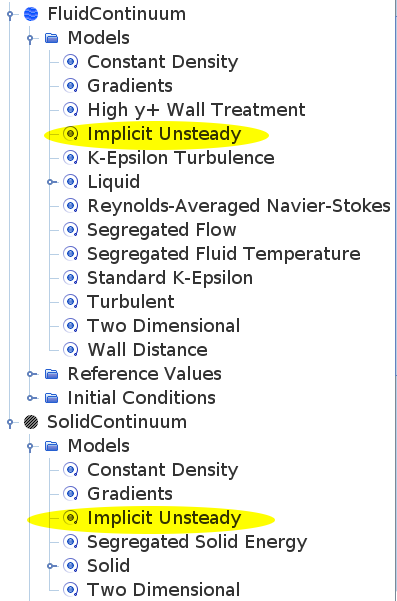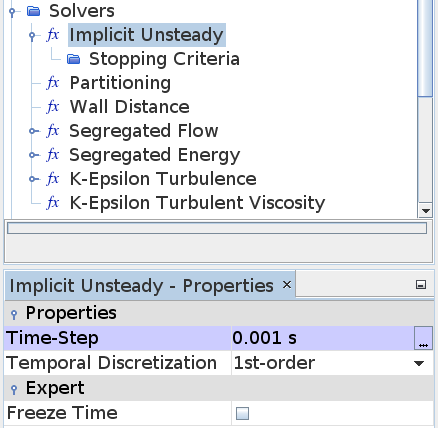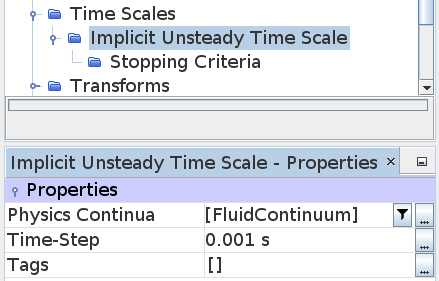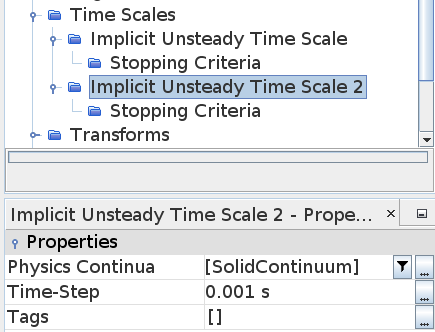Multiple Time Scales
Time Scales provide a method for grouping multiple continua together and specifying stopping criteria (and time-step size in case of unsteady modeling) for each continua group. Time scales provide greater granularity for solving problems with multiple time scales where multiple groups of continua must share the same time solver (steady, implicit unsteady, PISO unsteady, and so on) but still require different sets of stopping criteria and time-step size.
When you use time scales, all physics continua (with a region) must be assigned to a time scale. You cannot define a simulation where some physics continua are assigned to time scales and some are not.
Adding a Time Scale
- To add a new time scale node, right-click and select , PISO Unsteady,
Harmonic Balance, or
Steady. Options depend on the
time models already selected.

- Select the [time scale] node and set the Physics Continua to which the time scale applies. You can choose more than one continuum provided they require the same time model (for example, Implicit Unsteady).
- If the time scale is for an unsteady solver, set the Time-Step.
- Right-click the Stopping Criteria node and create any specific criteria by which to control the number of steps or time-steps for which the solver runs.
Example Usage: Single solver, multiple continua, and multiple time scales
Consider a scenario in which you have a fluid continuum and a solid continuum but wish to apply different time-steps when running the solvers in each continuum.
- Initial Setup
- Both fluid and solid continua have the Implicit Unsteady model selected.
- Only one Implicit Unsteady solver is added to the Solvers node. This solver operates for both the physics continua.
- On the solver, in the absence of any time scales, the time-step and stopping criteria apply to both physics continua.


- Within the Automation node, add a new time scale.
The type of time scales available depend on the solvers chosen in the physics
continua.

- For this time scale, specify the Physics
Continua (in this case FluidContinuum), set the Time-Step, and define any specific stopping
criteria.

- Add another time scale and set Physics Continua to the other
physics continuum.

- Continue by setting the Time-Step required in the solid continuum, along with any other specific stopping criteria for this time scale.
- Select the node and, in the Solution toolbar, click Run. This action activates the physics continua associated with Implicit Unsteady Time Scale and runs the implicit unsteady solver according to the time-step and stopping criteria specified by this time scale. Global and solver level stopping criteria still apply.
- After the simulation completes, select the node and click Run. This action activates the physics continua associated with Implicit Unsteady Time Scale2 and runs the implicit unsteady solver according to the time-step and stopping criteria specified by this time scale. Global and solver level stopping criteria still apply.
You are advised to select time scales as simulation objects in the Solve Physics operation within a simulation operation sequence. By this approach you can achieve correct control over simulations with multiple time scales, including those that combine steady solvers with unsteady. See also: 求解物理.
Time Scales Manager Node Properties
- Active Time Scale
- The time scale currently in use in the simulation. Select from the drop-down menu.
Time Scale Node Properties
- Physics Continua
- The continua to which the time scale applies.
- Time-Step
- The time-step value used for this time scale. This value overrides time-step values given in the solvers. Not available for Steady and Harmonic Balance time scales. Available only with the Implicit Unsteady and PISO Unsteady time models.
Stopping Criteria Manager Node
This node is the same as other stopping criteria managers, with the same pop-up menu and Verbose option. See 设置停止条件.